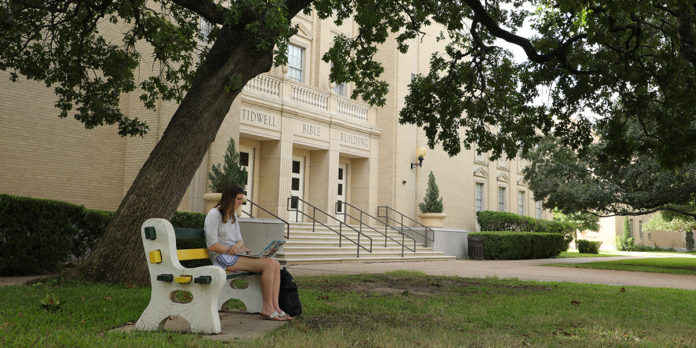
By Rachel Chiang | Reporter
After a 15-month renovation that started in 2020, Tidwell Bible Building reopened for the start of the fall 2021 semester. With the renovation, Tidwell is now able to display artifacts from biblical times that were acquired with the help of Dr. Bruce Cresson, a former professor in the Department of Religion.
These artifacts include a replica of a frieze depicting Ashurnasirpal II surrounded by two winged, bird-headed genii. According to Dr. Diedre Fulton, an associate professor in the Department of Religion, Ashurnasirpal II was the king of Assyria in the 9th century, and the replica was copied from a relief that used to be a part of his palace in the city of Nimrud. In the frieze, both genii are seen carrying pinecones.
“Pinecones are some kind of fertility blessing that’s involved in a lot of scenes that the Assyrians put in their art,” Fulton said. “And to the left there, this highly stylized image is what we believe is the Tree of Life.”
In addition to the frieze, Tidwell has glass cases full of artifacts from the Middle East, and according to Joyce Swoveland, the office manager in the Department of Religion, Cresson acquired most of them in the mid-70s.
“[Cresson] was an archeologist who worked in Israel, and at the time, you could still bring artifacts to the United States and it was completely acceptable,” Fulton said.
Featured in the glass cases are different vessels of varying shapes and sizes suited for different purposes. Many of them span from time periods centuries apart and come from all across Europe and the Middle East.
“Most of them are cooking vessels; most of them have to do with home life,” Swoveland said. “And some of it has to do with burial because they did bury their loved ones with cooking items. Some of them buried them with whole meals thinking they would need those in the afterlife.”
Apart from clay vessels, a brick from a wall supposedly built by Alexander the Great is featured in the cases, along with some oil lamps.
“This is a series of oil lamps going from around 3000 B.C. all the way up to the mid-century A.D., so we have over 3,000 years of history covered down here,” Fulton said.
Fulton said it was difficult to choose a particular piece that was her favorite because she really loved all of them, but she shared which ones piqued her interest the most.
“I’m very interested in how people cook, what people ate in the ancient world, so I love cooking pots,” Fulton said. “And that might seem really boring, because who goes and looks at your pots and pans in your house, but cooking pots tell you a lot about the foods they ate.”
Fulton said they are currently going through the publications and have been able to find the registration numbers on each artifact to see exactly what the excavators said about them. She also said they plan on putting together a pamphlet to show visitors what each item is and what it’s about.
“It’s really fun to see pieces of history connected in different ways to the Bible that is so easily accessible here at Baylor,” Fulton said. “We have pieces of history right here in Tidwell that are rare to have in collections at colleges and universities. And the fact that you can, with your own eyes, see these pieces that have been excavated from different digs — they give you a snapshot of the daily life of somebody in biblical Israel. It’s pretty exciting.”





